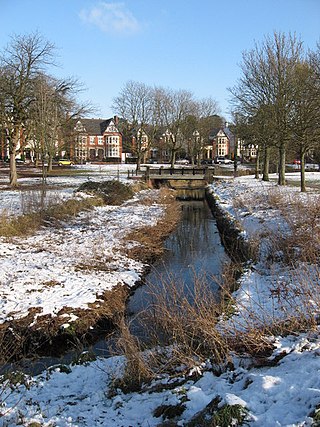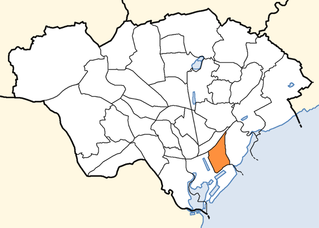
Cardiff Bay is an area and freshwater lake in Cardiff, Wales. The site of a former tidal bay and estuary, it is the river mouth of the River Taff and Ely. The body of water was converted into a 500-acre (2.0 km2) lake as part of a pre-devolution UK Government regeneration project, involving the damming of the rivers by the Cardiff Bay Barrage in 1999. The barrage impounds the rivers from the Severn Estuary, providing flood defence and the creation of a permanent non-tidal high water lake with limited access to the sea, serving as a core feature of the redevelopment of the area in the 1990s.

Marquess of the County of Bute, shortened in general usage to Marquess of Bute, is a title in the Peerage of Great Britain. It was created in 1796 for John Stuart, 4th Earl of Bute.

John Patrick Crichton-Stuart, 3rd Marquess of Bute, was a Scottish landed aristocrat, industrial magnate, antiquarian, scholar, philanthropist, and architectural patron.

Roath is a district and community to the north-east of the city centre of Cardiff, capital of Wales. The area is mostly covered by the Plasnewydd electoral ward, and stretches from Adamsdown in the south to Roath Park in the north.

Splott is a district and community in the south of the city of Cardiff, capital of Wales, just east of the city centre. It was built up in the late 19th century on the land of two farms of the same name: Upper Splott and Lower Splott Farms. Splott is characterised by its once vast steelworks and rows of tightly knit terraced houses. The suburb of Splott falls into the Splott electoral ward.

Cathays is a district and community in the centre of Cardiff, capital of Wales. It is an old suburb of Cardiff established in 1875. It is densely populated and contains many Victorian terraced houses. The area falls into the Cathays ward. It is the third most populous community in Cardiff, having a population of 18,002 in 2011.

Butetown is a district and community in the south of the city of Cardiff, the capital of Wales. It was originally a model housing estate built in the early 19th century by the 2nd Marquess of Bute, for whose title the area was named.

Penylan is a district and community in the east of Cardiff, the capital city of Wales, known for its Edwardian era period houses and spacious tree lined roads and avenues.

The Diocese of Llandaff is an Anglican diocese that traces its roots to pre-Reformation times as heir of a Catholic bishopric. It is headed by the Bishop of Llandaff, whose seat is located at the Cathedral Church of Saint Peter and Saint Paul in Llandaff, a suburb of Cardiff. It currently covers most of the former Welsh county of Glamorgan, but once stretched from the River Towy to the middle of the Wye Valley.

John Prichard was a Welsh architect in the neo-Gothic style. As diocesan architect of Llandaff, he was involved in the building or restoration of many churches in south Wales.
The Cardiff Deanery is a Roman Catholic deanery in the Archdiocese of Cardiff that oversees several churches in the city of Cardiff. It replaced the previous Cardiff East Deanery and Cardiff West Deanery, combining the two into one. The dean is centred at the Parish of St Mary's Canton.

Alexander Roos was an Italian-born British architect and urban planner. He was the architect to the Bute Estates in South Wales, for which he designed many buildings and laid out several areas of Cardiff.

St Peter's Church, Roath is the oldest surviving Roman Catholic church in Cardiff, the capital of Wales. It is administered by the Rosminians.

Eglwys Dewi Sant is a Grade II listed church building in the centre of Cardiff, Wales. It is the only church in the Diocese of Llandaff to conduct its services exclusively in the Welsh language.

Cardiff County Borough Council, known as Cardiff City Council after Cardiff achieved city status in 1905, was the elected local authority that administered the town and county borough of Cardiff, Glamorgan, Wales between 1889 and 1974. The county borough council was replaced in 1974 by a district council, covering part of South Glamorgan and also known as Cardiff City Council.

Sophia Frederica Christina Crichton-Stuart, Marchioness of Bute was a Scottish noblewoman. She was the second wife of John Crichton-Stuart, 2nd Marquess of Bute, and the mother of the 3rd Marquess. Cardiff's Sophia Gardens are named after her.
The Cardiff Combination Football League is a football league covering the city of Cardiff and surrounding areas in South Wales. The leagues are at the seventh, eighth and ninth levels of the Welsh football league system.

St Joseph's Church, is a Roman Catholic church in Cardiff, Wales. It is administered by the Rosminians. It serves the areas of Gabalfa, Cathays, and Maindy.




















